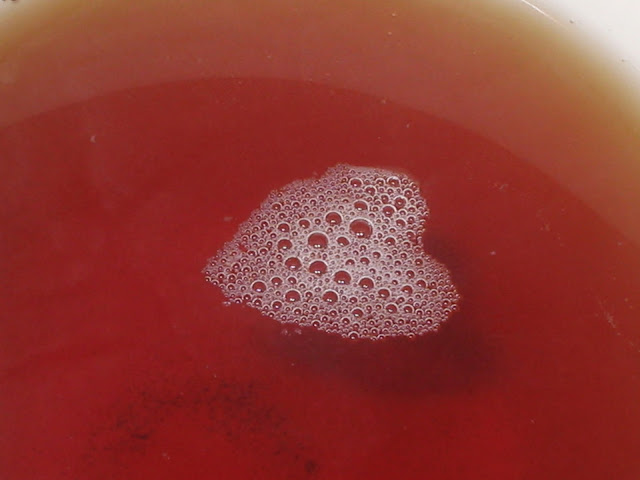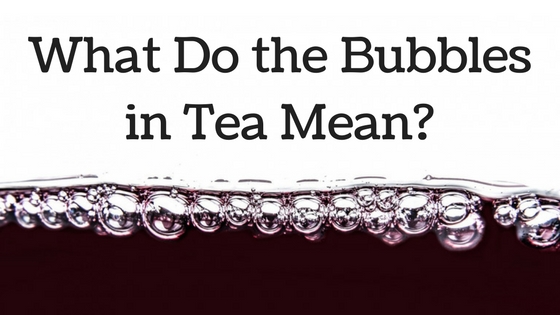Every once in a while, I see the same question pop up on message boards like TeaChat and Reddit. What does it mean when there are bubbles in tea? We’re not talking about bubble tea (aka bobba) here! Several substances can cause bubbles, foam, or even the mythical “tea pearl” to form when the leaves come into contact with hot water. Here is a list of just a few of them and what they might mean for your tea.
Tannins
Tannins are polyphenols found in plant matter. They have a bitter taste and are responsible for brown coloring, like what we see in black tea. Tannins are also a natural foaming agent. I have kept betta fish as pets on and off for most of my life. It is a common practice to place Indian Almond Leaf in aquariums to add tannins. This makes it easier for the betta fish to make their infamous bubble nest. Contrary to popular belief, there is no tannic acid in tea.
Saponin
Saponin is a

Saponin – a foaming agent naturally found in tea
Pectin
Pectin is a stabilizing agent that is used in jams, jellies, and dessert fillings. It is naturally found in most plants as well as fruits and vegetables. Pectin can cause a fruity flavor in oolongs and plays a role in good quality tea’s viscous mouthfeel. When it comes to brewed tea, pectin is also a common foaming agent. When I first go into tea, everyone on TeaChat was talking about the mythical tea pearl (a mysterious bubble that remains on the surface rather than popping). Pectin is part of what makes that phenomenon happen.
Proteins and Amino Acids
Tea leaves contain proteins and amino acids. These can create bubbles or foam when they come into contact with hot water. Teas that were harvested in early spring and tea where the cell walls have been broken (heavily rolled or CTC) seem to produce this effect more than others.
Microwaving
In the case of tea that has been microwaved, water that has been heated in this way will often boil without forming bubbles. When an object (like a tea bag) is added, it creates nucleation points that allow gas pockets to form. Personally, I find the foam on microwaved tea to be very unpalatable.

Whether or not bubbles in tea are a bad thing to have in your tea is often debated. Many tea drinkers will skim the bubbles or foam from the rinse or first infusion in the hopes of removing dust or impurities. Personally, I don’t follow this method. If the tea is contaminated, you’re going to be drinking some nasty stuff no matter what you do. Different ways of preparing tea give different results as well. In Morocco, tea is traditionally poured from a height to create foam purposely.
Where do you stand on bubbles in tea? Do you have a favorite tea or preparation method that causes a lot of foam? Let me know about it in the comments!
Chemical structure of Saponin by Cacycle – Own work, Public Domain, Link

That one is actually a stock photo but I thought it was too cool not to use 🙂
That is interesting. I'll have to brew some up to see how many bubbles I can get 🙂
I found out that Rou Gui and TieLuoHan usually make more bubbles than other teas, at least in their medium-high quality.
Over the years I’ve identified that tea with sugar forms bubbles in the middle of the cup/mug, without sugar bubbles form around the edge, I think sugar increases the surface tension of the liquid.
I’ve been brewing my wife’s morning cuppa for the last year. I would try to make sure there were what I told her were “love bubbles”. This I could easily engineer by plopping the milk in, which would create some lovely big ones. It always started the day off with a smile. Our brew of choice? Yorkshire Gold (because tea grown in Yorkshire is bound to be superior). This week I switched us to Barry’s gold, a tea of my irish youth (because where else would you grow fine tea). Guess what? No matter how I try, not one love bubble once i put the milk in. What’s going on there? Your lovely article doesn’t tell me what is going on there. Do bubbles indicate a superior blend or not? Or is it entirely unimportant? Tbh, both teas taste fine, although for the first time in my 60 years I can actually taste the difference between two blends. No complaints about the tea from the missus, but she does miss the love bubbles!
How sweet of you to make tea for your wife! It’s hard to say since both teas are proprietary blends with similar origins (Rwanda, Kenya, and Assam). It does sound like Yorkshire Gold has more saponin. That could be because it contains more buds or there might be a higher percentage of the Assamica vs the Sinensis variety. I don’t think there’s too much difference betweem them, but these two brands do have some very loyal and dedicated fans who might disagree with me.